Sous Vide 180 MODERN SOUS VIDE RECIPES THE ART & SCIENCE OF PRECISION COOKING AT HOME  BY TINA B BAKER Copyright 2017 - All rights reserved. This document is geared towards providing exact and reliable information in regards to the topic and issue covered. The publication is sold on the idea that the publisher is not required to render an accounting, officially permitted, or otherwise, qualified services. If advice is necessary, legal or professional, a practiced individual in the profession should be ordered. From a Declaration of Principles which was accepted and approved equally by a Committee of the American Bar Association and a Committee of Publishers and Associations. In no way is it legal to reproduce, duplicate, or transmit any part of this document by either electronic means or in printed format.
BY TINA B BAKER Copyright 2017 - All rights reserved. This document is geared towards providing exact and reliable information in regards to the topic and issue covered. The publication is sold on the idea that the publisher is not required to render an accounting, officially permitted, or otherwise, qualified services. If advice is necessary, legal or professional, a practiced individual in the profession should be ordered. From a Declaration of Principles which was accepted and approved equally by a Committee of the American Bar Association and a Committee of Publishers and Associations. In no way is it legal to reproduce, duplicate, or transmit any part of this document by either electronic means or in printed format.
Recording of this publication is strictly prohibited, and any storage of this document is not allowed unless with written permission from the publisher. All rights reserved. The information provided herein is stated to be truthful and consistent, in that any liability, regarding inattention or otherwise, by any usage or abuse of any policies, processes, or directions contained within is the solitary and utter responsibility of the recipient reader. Under no circumstances will any legal responsibility or blame be held against the publisher for any reparation, damages, or monetary loss due to the information herein, either directly or indirectly. Respective authors own all copyrights not held by the publisher. The information herein is offered for informational purposes solely and is universal as so.
The presentation of the information is without a contract or any guarantee assurance. The trademarks that are used are without any consent, and the publication of the trademark is without permission or backing by the trademark owner. All trademarks and brands within this book are for clarifying purposes only and are the owned by the owners themselves, not affiliated with this document.  Pork Belly Sliders Pistachio Ice Cream GET YOUR GIFT 25 LATE-NIGHT RECIPES UNDER 150 CALORIES FOR FREE SIGN UP HERE
Pork Belly Sliders Pistachio Ice Cream GET YOUR GIFT 25 LATE-NIGHT RECIPES UNDER 150 CALORIES FOR FREE SIGN UP HERE 

CHAPTER 1
How To Cook Sous Vide?
Cooking Sous Vide is much easier than you think. Before you start the cooking, you need to have the proper equipment. When it comes to ingredients, you do not have to give them some special attention.
Most of the components, just need some basic spices to shine. To get started, you will need to fill your Sous Vide machine with water and preheat water to the desired temperature. While your water is heating, you can prepare the ingredients. Season the ingredients to taste, and place in individual Sous Vide bag. We are saying special bags, as you cannot use plain bags. Any other type of bag may leak in, and destroy your elements.
Only bags specially designed for the Sous Vide cooking is appropriate to use. Once the components are in the right bag, you need to vacuum them. Use a vacuum sealer to remove all air from the pack. If you do not have a vacuum sealer, you can do the vacuuming with a water bath method. For the vacuuming ingredients with a water bath, gently place the filled bag into a water bath, making sure the water does not enter the container. Let the pressure of water press the air through the top of the bag.
When the air is out (or the most is out) seal the bag above the water line. Once you complete these steps, it is time to cook the food. The Sous Vide Cooking is all about temperature and measuring as these factors will determine the texture and the flavor of your dish. Selecting the correct temperature is essential. Sous Vide cooking temperature is in a range of 115-190F, and always below boiling. The key to successful sous vide cooking is maintaining a constant temperature through the baking period.
Just one degree below or above can change the final flavor and appearance. Here are quick references to cooking temperatures: - Poultry white meat 140-146F and up to 160F - - Poultry dark meat 176F - - Meat 134F (rare), 140F(medium), 150F (medium well) - - Fish 126F and up to 140F - - Shellfish 135-140F - - Veggies 185F - - Eggs 147F for soft boil, 167F to hard boil - - Cakes 190F
Sous Vide machines are straightforward to use, and you do not have to be a master chef to make food with one. When speaking about Sous Vide cooking methods, there are two main types of Sous Vide methods sous vide ovens also known as sous vide cookers and immersion circulators. At the time, we will stick to the sous vide ovens. Sous Vide ovens are the all-in-one package for cooking Sous Vide. This machine contains a water reservoir (where you place you vacuum sealed food) and digital thermometers and timers (you use to cook food at accurate temperature correctly).
Some of the best Sous Vide machines are: Sous vide ovens The simplest way to get into the sous vide lifestyle is to buy an all-in-one-machine, also called sous vide oven. Sous vide ovens include a reservoir that precisely heats and circulates the water bath, digital thermometers and timers to ensure perfect cooking, and sometimes even vacuum sealers to package up your food before its bath. The machines can be bulky, but you may prefer one bulky machine to three or four smaller appliances. Many of the machines are designed with the sleek, stylish kitchen in mind, including two of my favorites, the Tribest Sousvant and the Oliso Pro. The Oliso Pro even includes an induction cooktop, so you can sear your sous vide food to a golden-brown finish without ever pulling out a pan. Some sous vide ovens at lower price points resemble office printers but still get the job done.
At this price point, I suggest the Sous Vide Supreme Demi, a boxy but compact oven thats perfect for smaller families. Immersion circulators If youd like equally precise sous vide method with a less expensive entry point, try looking into immersion circulators instead of all-in-one sous vide ovens. Immersion circulators are small, handheld gadgets that make any water-filled basin into a sous vide machine. They draw up water from the basin, heat it to a set temperature, and release the heated water back into the basin, maintaining a precise level of heat and speed of circulation. The circulators are similar in size and shape to an immersion blender and take up the same amount of space in your kitchen. The immersion circulator market is exploding right now, with every company trying to outpace the next with one more bell or whistle.
Most of them do the trick, but some are sleeker and more impressive than others. We suggested the Sansaire, a beautifully elegant device that heats water within a tenth of a degree Fahrenheit. More tech-minded cooks may be interested in the Anova WiFi Precision Cooker, which sends notifications to your cell phone about how your food is doing. Once youve chosen a circulator, you can opt to either buy dedicated sous vide container or use one of the large pots you already have as your water basin. Youll also need to buy a vacuum sealer, and then youre all set to start cooking. DIY alternatives If youd prefer not to invest in a brand-new kitchen appliance just to test out a method of cooking, dont fret; there are sous vide options for you, too.







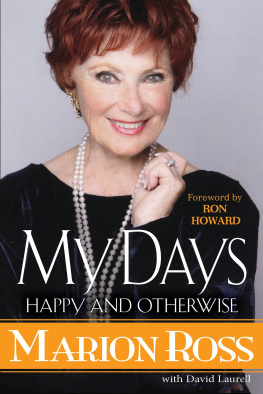
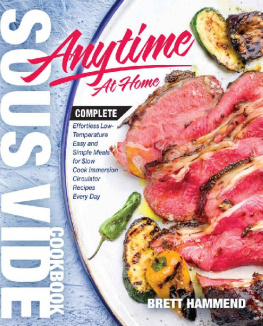

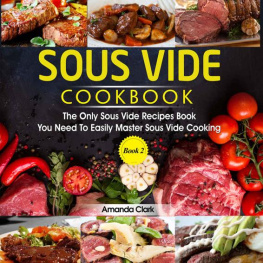
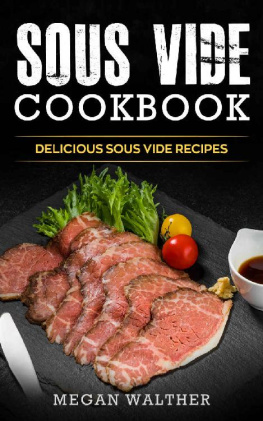
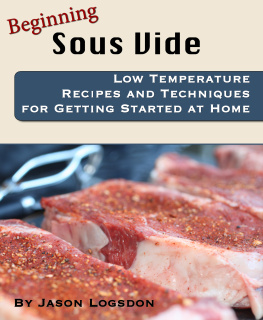

 BY TINA B BAKER Copyright 2017 - All rights reserved. This document is geared towards providing exact and reliable information in regards to the topic and issue covered. The publication is sold on the idea that the publisher is not required to render an accounting, officially permitted, or otherwise, qualified services. If advice is necessary, legal or professional, a practiced individual in the profession should be ordered. From a Declaration of Principles which was accepted and approved equally by a Committee of the American Bar Association and a Committee of Publishers and Associations. In no way is it legal to reproduce, duplicate, or transmit any part of this document by either electronic means or in printed format.
BY TINA B BAKER Copyright 2017 - All rights reserved. This document is geared towards providing exact and reliable information in regards to the topic and issue covered. The publication is sold on the idea that the publisher is not required to render an accounting, officially permitted, or otherwise, qualified services. If advice is necessary, legal or professional, a practiced individual in the profession should be ordered. From a Declaration of Principles which was accepted and approved equally by a Committee of the American Bar Association and a Committee of Publishers and Associations. In no way is it legal to reproduce, duplicate, or transmit any part of this document by either electronic means or in printed format. Pork Belly Sliders Pistachio Ice Cream GET YOUR GIFT 25 LATE-NIGHT RECIPES UNDER 150 CALORIES FOR FREE SIGN UP HERE
Pork Belly Sliders Pistachio Ice Cream GET YOUR GIFT 25 LATE-NIGHT RECIPES UNDER 150 CALORIES FOR FREE SIGN UP HERE 
